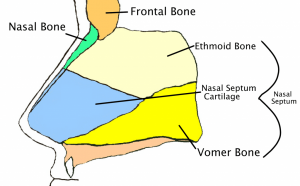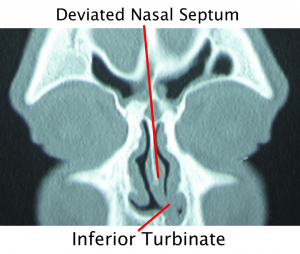Your path to breathing better begins here: Solve your deviated septum issue
For Upper West Side residents who notice consistent nasal congestion or difficulty breathing through one or both nostrils, a deviated septum may be the underlying cause. This condition involves a displacement of the nasal septum that can interfere with normal airflow and contribute to additional complications over time. Dr. Mourad focuses on identifying the severity of the deviation and providing expert care. His approach to septoplasty offers Upper West Side patients an effective solution to restore clear breathing, relieve discomfort, and promote optimal nasal health.
Relieve your breathing problems with septoplasty in the Upper West Side – Meet with Dr. Mourad
Septoplasty Procedure to Improve the Nasal Passages
Designed to address issues stemming from a deviated septum, septoplasty is a surgical intervention that focuses on improving the flow of air through the nasal passages while also enhancing the structural framework of the nose. This outpatient procedure involves carefully adjusting, reshaping, or repositioning the cartilage and bones inside the nasal cavity to correct alignment problems. Patients who undergo septoplasty often experience relief from common issues such as persistent nasal congestion, breathing difficulties, and discomfort associated with septal deviation. The procedure supports both functional improvement and overall nasal health, allowing individuals to enjoy clearer breathing and increased comfort in daily life.

How Can Dr. Mourad Improve my Quality of Life with Deviated Septum Surgery?
Patients from Upper West Side often arrive at our clinic after using numerous treatments such as nasal sprays containing steroids, decongestants, or antihistamines, but still find it difficult to breathe comfortably or manage chronic nasal issues. Our approach involves a thorough review of all potential treatment options so that you understand the benefits and considerations of each choice and feel confident in moving forward with your care plan. In addition, our team assists with verifying insurance coverage and navigating the administrative requirements, helping to simplify the process for patients. With extensive experience in all types of nasal surgery, Dr. Mourad personally ensures that every patient receives individualized attention and the highest standard of medical care.
Do I Need a Septoplasty?
Whether a patient requires septoplasty is determined by the presence of a deviated septum that may be causing health problems or symptoms that noticeably affect daily living. Typical issues prompting consideration of this surgery include nasal obstruction that makes breathing difficult, recurring sinus infections, frequent bleeding from the nose, loud snoring, and conditions such as sleep apnea.
Initially, non-surgical management options like nasal sprays, both prescription and over-the-counter, may be recommended to alleviate symptoms and improve airflow. If these treatments fail to provide sufficient relief or if the symptoms remain severe, septoplasty is generally advised as the most effective solution. Scheduling a consultation at our NYC clinic allows patients to receive a thorough evaluation from a facial plastic and reconstructive surgeon who will provide an informed and personalized treatment plan.

Common Symptoms of a Deviated Nasal Septum
Identification of a deviated septum generally occurs when individuals experience persistent signs including difficulty breathing through the nose, continuous facial pressure or pain, and repeated occurrences of sinus infections. If these problems reach a level where they significantly disrupt normal breathing or day-to-day activities, septoplasty surgery may be recommended to correct the issue. The procedure involves precise adjustment and realignment of the nasal cartilage and bone, improving both nasal function and overall comfort for the patient.
- Sleep Apnea and Other Sleeping Problems: When the nasal septum is misaligned, airflow during sleep can be compromised, which may contribute to obstructive sleep apnea. This disruption can lead to restless nights, frequent awakenings, and excessive daytime tiredness. Septoplasty is often recommended to correct the structural irregularities, improve airflow, and enhance the quality of sleep while reducing the negative health effects associated with sleep-disordered breathing.
- Chronic Nose Congestion or Nasal Obstruction: Long-term nasal blockage, often a result of a deviated septum, can make normal breathing a challenge. Surgical correction of the septum can reestablish proper airflow, alleviate chronic congestion, and enhance respiratory comfort, allowing patients to breathe more easily both during the day and at night.
- Chronic Sinusitis and Sinus Infections: A crooked septum can interfere with the natural drainage of the sinuses, leading to recurring infections. By realigning the nasal structure through surgery, airflow is improved, sinus drainage becomes more efficient, and the risk of recurrent sinusitis is significantly reduced.
- Nasal Discharge (Runny Nose): Deviations in the nasal septum can irritate the lining of the nose, causing continuous nasal discharge or a runny nose. Surgical correction can restore balanced airflow, reduce excess mucus production, and improve overall nasal function.
- Nasal Polyps: The presence of nasal polyps, which are soft and noncancerous, may accompany a deviated septum and obstruct the nasal passages. These polyps can affect the sense of smell and increase the likelihood of infections. Surgical intervention may be recommended to remove obstructions and optimize nasal airflow.
- Symptoms Similar to Allergies: Structural problems in the nose, such as a deviated septum, can mimic the symptoms of allergic reactions, including congestion and sneezing. Accurate evaluation is necessary to distinguish structural causes from true allergies, and in many cases, surgical correction may provide the most effective resolution.
Why Choose Mourad NYC for Septoplasty Surgery in the Upper West Side?
Selecting Mourad NYC for your septoplasty procedure provides access to surgeons with deep knowledge of nasal anatomy and refined, precise surgical skills. The Upper West Side facility prioritizes individualized treatment that considers both the functional and visual outcomes of nasal procedures. Patients seeking relief from breathing difficulties, correction of a deviated septum, or combined procedures including rhinoplasty will find that Mourad NYC offers the latest technology along with an attentive, patient-centred process. Entrusting Dr. Mourad with your care means working with a facial plastic surgeon dedicated to achieving excellent results while ensuring recovery is safe and comfortable. Septoplasty performed in the Upper West Side through this practice can lead to better airflow, improved sleep, and a noticeable enhancement in overall well-being.
Learn More About Deviated Septum Surgery at Mourad NYC
What is a Deviated Septum?
A deviated septum arises when the cartilage and bony framework of the nasal septum, which divides the left and right sides of the nasal cavity, is displaced or misaligned from its typical position. This structural abnormality can develop as a result of trauma to the nose, including accidents or sports-related injuries, or it may be present from birth due to developmental differences. Symptoms associated with a deviated septum often include chronic congestion, difficulty breathing comfortably through the nose, and the potential growth of nasal polyps that further obstruct airflow. Corrective surgical procedures, such as septoplasty or rhinoplasty, aim to realign the septum, improve breathing efficiency, and optimize the functional performance of the nose.
Does Health Insurance Pay For This Type Of Nasal Surgery?
Functional nasal surgeries, designed to improve breathing and the overall performance of the nasal passages, are generally covered by most health insurance plans. At our Upper West Side office, we ensure that every patient receives a detailed review of their coverage and a clear explanation of any costs they may need to manage if septum surgery is recommended.
We place great emphasis on eliminating surprises and making the financial aspect of care fully transparent. This process involves clarifying co-pays, deductibles, and coinsurance responsibilities so that patients can approach treatment with confidence. It is essential to note that cosmetic procedures, including aesthetic rhinoplasty or elective eyelid surgery, are excluded from insurance coverage and must be addressed through separate payment arrangements.
What is the Cost of a Septoplasty Surgery in NYC?
In New York City, the average cost for facial plastic surgery to correct a deviated septum is typically estimated to fall between $4,000 and $10,000. It is important to keep in mind that this range serves only as a general approximation, and the final cost for each patient can vary depending on the complexity of the nasal condition, additional procedures required, and individual circumstances.
Several factors contribute to the overall cost of septoplasty in NYC. These include the surgeon’s professional fee, the cost of anesthesia, operating room or surgical facility charges, and post-operative care such as follow-up visits and any necessary medications. For a more accurate and personalized estimate, patients are encouraged to schedule a consultation with an experienced facial plastic surgeon. During this session, the surgeon can examine your nasal anatomy, evaluate whether additional techniques or rhinoplasty procedures may be needed, and provide a thorough cost assessment tailored specifically to your situation.
What is the recovery time following septoplasty?
The healing process after a septoplasty procedure is different for each patient, but most individuals can generally expect to resume light daily activities or return to work that does not require physical exertion within roughly one week. The complete resolution of internal swelling and the restoration of full nasal function may take anywhere from three to six months. During the early stages of recovery, patients should avoid strenuous exercise, refrain from blowing their nose, and take precautions to protect the nasal area from injury or accidental impact.
Are There Other Conditions That Can Block Your Nasal Airway?
Aside from septal deviation, other structural or medical issues can block normal nasal airflow. Common examples include enlarged turbinates, nasal polyps, and persistent sinus infections that contribute to ongoing congestion. Considering these conditions carefully and discussing the advantages and potential risks of surgical treatment options, such as septoplasty, is an important step toward achieving improved breathing and overall nasal health.
What are potential risks of deviated septum surgery?
Septoplasty, while generally safe and effective, carries potential risks and complications as with all surgical procedures. Being fully informed about these risks helps patients make thoughtful decisions regarding their care, understand the possible outcomes, and take proper precautions to ensure the best results throughout the recovery process.
Nose Infection
Infections within the nasal cavity or at the surgical site can occur as a potential post-operative complication. To minimize this risk and promote optimal recovery, patients must carefully follow all post-surgery care instructions, including completing the full course of any prescribed antibiotics and attending all follow-up appointments for monitoring.
Septal Perforation
A septal perforation occurs when a hole forms in the cartilage of the nasal septum. Although uncommon, this complication can interfere with airflow through the nose and may require additional medical evaluation or corrective surgery to restore normal nasal function and structure.
Prolonged or Intense Pain
Some discomfort is normal after nasal surgery, but persistent or intensified pain can signal complications. These may include hematoma formation, slow tissue healing, or other post-surgical issues that require prompt attention to avoid long-term problems.
Facial Pain
Surgical adjustments to the nasal cartilage or bones can cause temporary facial pain. Discussing this possibility during initial consultations helps patients form realistic expectations regarding post-operative discomfort and understand the recovery process more thoroughly.
Persistent Nasal Congestion
Extended or severe nasal congestion beyond the typical recovery period may indicate complications or alterations in airflow caused by the surgery. Careful observation and timely intervention can help address these issues and ensure proper healing.
Nasal Packing Complications
Nasal packing, sometimes used to manage bleeding, can cause discomfort and, if not removed or monitored properly, may result in additional complications. Ensuring correct technique and vigilant care is necessary for a safe recovery.
Alterations to Nasal Structure
All surgical procedures have the potential to alter the nose’s shape and structure, including the underlying cartilage and bone. Patients should engage in detailed discussions with their surgeon about their goals and expectations to prevent surprises and achieve results that meet both aesthetic and functional objectives.

